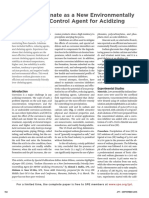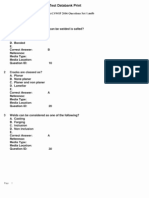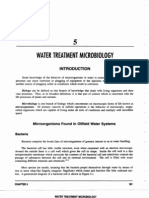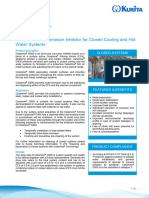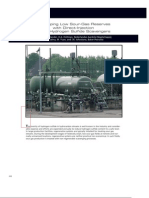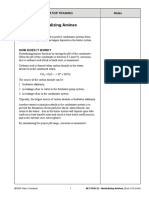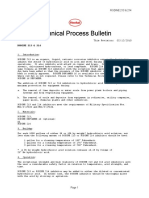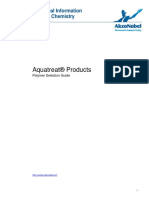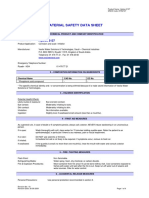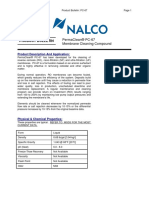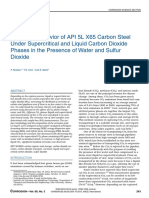0 ratings0% found this document useful (0 votes)
90 viewsSelecting A Corrosion Inhibitor PDF
Selecting A Corrosion Inhibitor PDF
Uploaded by
TariqCopyright:
© All Rights Reserved
Available Formats
Download as PDF, TXT or read online from Scribd
Selecting A Corrosion Inhibitor PDF
Selecting A Corrosion Inhibitor PDF
Uploaded by
Tariq0 ratings0% found this document useful (0 votes)
90 views3 pagesOriginal Title
Selecting A Corrosion Inhibitor.pdf
Copyright
© © All Rights Reserved
Available Formats
PDF, TXT or read online from Scribd
Share this document
Did you find this document useful?
Is this content inappropriate?
Copyright:
© All Rights Reserved
Available Formats
Download as PDF, TXT or read online from Scribd
Download as pdf or txt
0 ratings0% found this document useful (0 votes)
90 views3 pagesSelecting A Corrosion Inhibitor PDF
Selecting A Corrosion Inhibitor PDF
Uploaded by
TariqCopyright:
© All Rights Reserved
Available Formats
Download as PDF, TXT or read online from Scribd
Download as pdf or txt
You are on page 1of 3
Milacron Marketing Co.
| Consumable Products Division | Cincinnati, Ohio 45209
Selecting A Corrosion
Inhibitor
INTRODUCTION
Corrosion, an ongoing concern for industry, may Cold Rolled Steel Corrosion
cause reduced service life or complete failure of
manufactured parts and finished goods. These issues
directly impact the cost efficiency of the manufacturing
process and cost of the finished goods. Corrosion
inhibitors can be used to prevent the problems
associated with corrosion
WHAT IS CORROSION?
Corrosion is the destructive attack to metal by a
chemical or electrochemical reaction with its
environment.
Aluminum Staining
The terms corrosion and rusting are often used
interchangeably. The term “rust” typically is applicable
to ferrous materials, iron and steel. The most term to
use is "corrosion" because it is inclusive of non-ferrous
metals as well.
Metallic staining is light corrosion resulting in Cast iron with and without corrosion
discoloration or tarnish of the metallic surface. Staining
does not need a wet environment to occur. Staining
may be white and powdery, green, black or brown in
color. This type of corrosion is generally found with What is a Corrosion Inhibitor?
aluminum, brass & copper materials.
A corrosion inhibitor is a material that attaches or coats
the metal surface, providing a protective barrier film,
Examples of Corrosion which in turn stops the corrosive reaction from
developing. Temporary coatings are often used to
prevent corrosion during storage and shipment, and
between machining or processing operations. The most
effective corrosion inhibitor coatings, at one time, were
oil or solvent-based materials. In recent years water
based products have been developed and are being
used with success.
Galvanized part with white corrosion
“Selecting A Corrosion Inhibitor”
Milacron Marketing Co. Technical Report No. 2/03
Page 1 of 3
2/03
CIMCOOL® Technical Report
Milacron Marketing Co. | Consumable Products Division | Cincinnati, Ohio 45209
Choosing a Corrosion Inhibitor
Water-Based Inhibitors
When choosing the corrosion inhibitor for your
application several things need to be considered. Water-based corrosion inhibitors rely on modifying the
• Materials to be protected characteristics of the metal surfaces themselves to
• Protection effectiveness timeframe (1week, 1 decrease their susceptibility to oxidation and corrosion
month, 1 year, etc.) formation. Water-based inhibitors are typically sold as
• Method of application (dip, spray, brush, etc.) a concentrate and diluted with water for use, making
• Type of protection required (in process, storage or their cost less than most oil/solvent-based products.
shipping)
• Part handling and fingerprint suppression Water-based corrosion inhibitors generally have very
• Type and thickness of coating residue desired desirable characteristics. The chemical films formed
• Storage, packaging and/or shipping conditions are thin and typically transparent when dry. Application
(temperature, humidity & seasonal conditions) methods for these coatings include spray, brush or
• Removal methods (if required) immersion. They are cleaner to use and eliminate
• Interaction with subsequent processes, if not concerns of solvent fumes. The films rarely have to be
removed removed prior to subsequent operations but if removal
• Environmental, health and safety requirements is necessary it is done easily with mild water-based
• Type of product (Oil/Solvent or Water-based) cleaners.
desired
Water-based inhibitors can be effective in preventing
corrosion for extended periods of time (weeks to
months) under reasonable plant storage and protected
shipping conditions. Since water-based products work
Oil/Solvent-Based Inhibitors by decreasing the susceptibility of the metal to
oxidation rather than by completely excluding water and
Corrosion inhibitors of this type rely principally on the air, these inhibitors often are not as effective as
formation of barrier coatings to prevent water from oil/solvent-based coatings in shipping and outside
contacting metal surfaces. These materials are storage of parts.
typically used direct from their container without any
need for thinning or preparation for use. For additional information on CIMCOOL CIMGUARD
Water-based Corrosion Inhibitors refer to Table 2 at
The protective coating they form varies (semi-hard, the end of this document.
soft, oily, transparent, colored) with the specific
product. Removal methods for these coatings are
dependent on the specific product and may vary from
the use of an alkaline cleaner or degreaser to the use
Supplemental Protection
of a solvent. The coatings can be applied by brush,
Adverse atmospheric conditions encountered during
dip, and spray methods.
shipping and long-term storage may require more
protection for the metal than that provided by oil/solvent
For parts that need longer term protection (months to
or waterbased corrosion inhibitors alone. In these
years) or those stored in severe environmental
cases Vapor-phase Corrosion Inhibitor (VCI) papers,
conditions (i.e. outside storage) oil-based inhibitors are
pellets or films may be used as supplemental
preferred due to their heavy film and the water
protection.
rejecting properties they possess.
For additional information on CIMCOOL CIMGUARD
Oil/Solvent Based Corrosion Inhibitors refer to Table1
at the end of this document. Consult with your regional CIMCOOL Technical
Service Engineer for specific recommendations, or call
CIMCOOL Technical Service at 1-513-458-8199.
“Selecting A Corrosion Inhibitor”
Milacron Marketing Co. Technical Report No. 2/03
Page 2 of 3
2/03
CIMCOOL® Technical Report
Milacron Marketing Co. | Consumable Products Division | Cincinnati, Ohio 45209
Table 1. Table 2.
“Selecting A Corrosion Inhibitor”
Milacron Marketing Co. Technical Report No. 2/03
Page 3 of 3
2/03
You might also like
- Cetamine G817 - TDS - E - 2015 04 13Document2 pagesCetamine G817 - TDS - E - 2015 04 13danielNo ratings yet
- Sodium Gluconate Iron Chelation ValueDocument2 pagesSodium Gluconate Iron Chelation ValueVenu KavetiNo ratings yet
- Agentes AntiescalaDocument7 pagesAgentes AntiescalaFabian ArboledaNo ratings yet
- Biocide TestingDocument9 pagesBiocide TestingVlassis SarantinosNo ratings yet
- Cswip 3.1 QuizDocument70 pagesCswip 3.1 Quizalzaki100% (1)
- Acumer 200Document2 pagesAcumer 200abdoelandhakimNo ratings yet
- IDA-97 Silica AntifoulantDocument18 pagesIDA-97 Silica AntifoulantCyrus CerezoNo ratings yet
- 8500-8773 DS NalcoDocument3 pages8500-8773 DS Nalcocarlos samilaNo ratings yet
- 05 AWT Water Treatment MicrobiologyDocument30 pages05 AWT Water Treatment Microbiologypofuduk_gsNo ratings yet
- International Water Conference Proceedings - 1940-2009Document5,199 pagesInternational Water Conference Proceedings - 1940-2009Alfonso Javier Medina PernethNo ratings yet
- A Volatile Oxygen Treatment SystemDocument10 pagesA Volatile Oxygen Treatment SystemmallinathpnNo ratings yet
- 3DT105 enDocument2 pages3DT105 enJulius MwakaNo ratings yet
- Section 24 Neutralizing Filming AminesDocument3 pagesSection 24 Neutralizing Filming AminesSheikh SahabNo ratings yet
- Water Log Newsletter - Jan 2013Document24 pagesWater Log Newsletter - Jan 2013Luis LicetNo ratings yet
- Acumer3100 Cooling PDFDocument7 pagesAcumer3100 Cooling PDFdalton2003No ratings yet
- Evaluation of Scale Inhibitors PerformanceDocument14 pagesEvaluation of Scale Inhibitors PerformanceLaura Natalia SalcedoNo ratings yet
- Diethyl Hydroxyl AmineDocument6 pagesDiethyl Hydroxyl AminemnasiroleslamiNo ratings yet
- !!!flyer - EU-Mirapol SurfN PDFDocument2 pages!!!flyer - EU-Mirapol SurfN PDFSlava75No ratings yet
- 216Document16 pages216Mehdi NasiroleslamiNo ratings yet
- Filming Corrosion Inhibitor For Oil and Gas FieldDocument20 pagesFilming Corrosion Inhibitor For Oil and Gas FieldelsyakiebNo ratings yet
- Chemicals Zetag DATA Powder Magnafloc 919 - 0410Document2 pagesChemicals Zetag DATA Powder Magnafloc 919 - 0410PromagEnviro.comNo ratings yet
- Acumer 4161 - PCADocument7 pagesAcumer 4161 - PCAManuel PerezNo ratings yet
- Kemira Solutions 0209 enDocument17 pagesKemira Solutions 0209 enmesru39No ratings yet
- BWA Belcor 575 Replaces Molybdate USA - WF 0Document2 pagesBWA Belcor 575 Replaces Molybdate USA - WF 0mnasiroleslami100% (2)
- Division Presentation - Care ChemicalsDocument18 pagesDivision Presentation - Care ChemicalsChris SongNo ratings yet
- Gengard Gn7004: Description and UseDocument2 pagesGengard Gn7004: Description and Useengr.shahid041No ratings yet
- BK 304 - Technical - Lessons - PAC1, 2 and 3 EU 2019 11Document53 pagesBK 304 - Technical - Lessons - PAC1, 2 and 3 EU 2019 11Andreea LilianaNo ratings yet
- Qatar Desalination ResearchDocument21 pagesQatar Desalination Researchmohamedcool90No ratings yet
- Cetamine G900 - enDocument2 pagesCetamine G900 - endanielNo ratings yet
- BT 58Document7 pagesBT 58dalton2003No ratings yet
- Volume 5 Phosphonate TestingDocument4 pagesVolume 5 Phosphonate TestingMiguel GonzalezNo ratings yet
- Developing Low Sour GasDocument12 pagesDeveloping Low Sour GasOilfieldJimNo ratings yet
- Neutralizing Amines Volume 10 Issue3Document3 pagesNeutralizing Amines Volume 10 Issue3Waleed Emara100% (1)
- BWA Belcor 575 Replaces Molybdate USA WF 0Document2 pagesBWA Belcor 575 Replaces Molybdate USA WF 0dalton2003No ratings yet
- Neutralizing Amines: Boiler Water Operator Training NotesDocument4 pagesNeutralizing Amines: Boiler Water Operator Training NotesSheikh SahabNo ratings yet
- Helamin 906 HDocument2 pagesHelamin 906 HWong Peng ChiongNo ratings yet
- 55-DS-1811 Rev 0Document1 page55-DS-1811 Rev 0Sunil G ParakkalNo ratings yet
- Water Soluble Polymers EDocument57 pagesWater Soluble Polymers Emini2018No ratings yet
- Rodine 213 & 214-EnDocument3 pagesRodine 213 & 214-EnLouis MoralesNo ratings yet
- Reverse Osmosis: Boiler Water Operator Training NotesDocument6 pagesReverse Osmosis: Boiler Water Operator Training NotesSheikh SahabNo ratings yet
- Nalco 77262: Boiler Treatment MultifunctionalDocument7 pagesNalco 77262: Boiler Treatment MultifunctionalMunir AbdullahNo ratings yet
- Aquatreat Selection GuideDocument3 pagesAquatreat Selection GuideMustafa KareemiNo ratings yet
- Deposit Control Polymers For Stressed Phosphate-Based Cooling Water SystemsDocument15 pagesDeposit Control Polymers For Stressed Phosphate-Based Cooling Water SystemsJohnNo ratings yet
- Hydrex 6316-EnDocument1 pageHydrex 6316-EnSayed SalahNo ratings yet
- Organic Phosphonate SaltsDocument3 pagesOrganic Phosphonate SaltsDee HsNo ratings yet
- Material Safety Data Sheet: Hydrex 2127Document4 pagesMaterial Safety Data Sheet: Hydrex 2127JHUPEL ABARIALNo ratings yet
- Application of Corrosion Inhibitors For Steels in Acidic MediaDocument25 pagesApplication of Corrosion Inhibitors For Steels in Acidic Mediajangri1098No ratings yet
- TDS Alcomer 7109Document2 pagesTDS Alcomer 7109PrototypeNo ratings yet
- Lightends FoulingDocument2 pagesLightends FoulingaliNo ratings yet
- Corroflux - Oilfield Scavenger RangeDocument6 pagesCorroflux - Oilfield Scavenger Rangeben7251No ratings yet
- BT 31Document9 pagesBT 31dalton2003No ratings yet
- Phosphinosuccinic Oligomer (PSO)Document3 pagesPhosphinosuccinic Oligomer (PSO)mirceablaga86100% (1)
- Substituted Alkylamine IDocument3 pagesSubstituted Alkylamine IFranklin Crespo AmoresNo ratings yet
- 1998 - Uphues - Chemistry of Amphoteric SurfactantsDocument8 pages1998 - Uphues - Chemistry of Amphoteric SurfactantsRizkyka AffiatyNo ratings yet
- Product Bulletin - PC-67Document4 pagesProduct Bulletin - PC-67Aymen HentatiNo ratings yet
- Safety Data Sheet NALCO® 8735: Section: 1. Product and Company IdentificationDocument10 pagesSafety Data Sheet NALCO® 8735: Section: 1. Product and Company IdentificationJunaidi NaidiNo ratings yet
- Antifoaming Agents Performance Evaluation... 7Document18 pagesAntifoaming Agents Performance Evaluation... 7dhavaleshNo ratings yet
- RyznarDocument12 pagesRyznarJim FrenkenNo ratings yet
- 00-Corrosión Inhibitor DOSES PDFDocument27 pages00-Corrosión Inhibitor DOSES PDFamazo_14No ratings yet
- Cleaning and disinfection of food factories: a practical guideFrom EverandCleaning and disinfection of food factories: a practical guideNo ratings yet
- Electode Equivalent China Standards (GB) Vs AWSDocument1 pageElectode Equivalent China Standards (GB) Vs AWSTariq100% (2)
- ASTM G170-2006 (2012) Evaluating and Qualifying Oilfield and Refinery CorrosionDocument3 pagesASTM G170-2006 (2012) Evaluating and Qualifying Oilfield and Refinery CorrosionTariqNo ratings yet
- API 571 SummaryDocument44 pagesAPI 571 SummaryTariq100% (2)
- Corrosion InhibitorDocument27 pagesCorrosion InhibitorTariq100% (4)
- Corrosion Behavior of API 5L X65 Carbon Steel Under Supercritical and Liquid Carbon DioxideDocument8 pagesCorrosion Behavior of API 5L X65 Carbon Steel Under Supercritical and Liquid Carbon DioxideTariqNo ratings yet
- Water Formed-Scale-bookDocument68 pagesWater Formed-Scale-bookTariqNo ratings yet
- Corrosion Technology Types of Metallic CorrosionDocument44 pagesCorrosion Technology Types of Metallic CorrosionTariq100% (2)
- NDT FormulaeDocument6 pagesNDT FormulaeTariqNo ratings yet
- MT 35 Oil Insoluble MaterialDocument11 pagesMT 35 Oil Insoluble MaterialFelipe NavarreteNo ratings yet
- Modelling and Simulation of Mechatronic SystemsDocument19 pagesModelling and Simulation of Mechatronic SystemsEnes Umur GökçekNo ratings yet
- Henri Sainte-Claire DevilleDocument8 pagesHenri Sainte-Claire DevilleCharles JacobNo ratings yet
- Graham CrackerDocument7 pagesGraham CrackerAniteiFlorinAlexandruNo ratings yet
- Roto Synthetic Fluid ULTRA: High Quality Synthetic Oil For Demanding ApplicationsDocument2 pagesRoto Synthetic Fluid ULTRA: High Quality Synthetic Oil For Demanding ApplicationsJoao BotasNo ratings yet
- How Gravity Replaces Thermodynamics: Prof.-Dr. Benjamin Gal-OrDocument58 pagesHow Gravity Replaces Thermodynamics: Prof.-Dr. Benjamin Gal-OrProf.-Dr. Benjamin Gal-OrNo ratings yet
- Auramix 201 TDS PDFDocument2 pagesAuramix 201 TDS PDFVarun KediaNo ratings yet
- 6 Residual Stresses and DistortionDocument15 pages6 Residual Stresses and DistortionNiranjan khatuaNo ratings yet
- The Use of Electrolytic Hygrometers For The Determination of Water and HydrogenDocument11 pagesThe Use of Electrolytic Hygrometers For The Determination of Water and HydrogenAC DCNo ratings yet
- Climate ChangeDocument11 pagesClimate ChangeResty Obina Jr.No ratings yet
- Parte 2 Mec TerDocument9 pagesParte 2 Mec TerJHONIER ANDRES TORRES URREANo ratings yet
- Fei 2018Document38 pagesFei 2018PN VinodNo ratings yet
- Product Data Sheet SP-2888 RGDocument8 pagesProduct Data Sheet SP-2888 RGJR RZNo ratings yet
- Buffer TablesDocument5 pagesBuffer TablesMahesh AithalNo ratings yet
- Save Environment Save LifeDocument18 pagesSave Environment Save LifeHarish GundaNo ratings yet
- Chemistry Book 2 Chapter - 15 (Common Chemical Industries in Pakisten)Document55 pagesChemistry Book 2 Chapter - 15 (Common Chemical Industries in Pakisten)Rana Hassan TariqNo ratings yet
- Atoms, Elements & Compounds 3 QPDocument10 pagesAtoms, Elements & Compounds 3 QPVyom agarwalNo ratings yet
- Hydraulic and Hydraulic MachinesDocument7 pagesHydraulic and Hydraulic MachinesAwanish PrajapatiNo ratings yet
- Impact Strength Vs Fracture ToughnessDocument2 pagesImpact Strength Vs Fracture ToughnessEdwardNo ratings yet
- 31 Basic Mathematics and Vectors Home AssignmentDocument8 pages31 Basic Mathematics and Vectors Home AssignmentHemant KumarNo ratings yet
- An Experimental Analysis of Process Parameters For EN-36C Alloy Steel Using CNC Lathe  " A ReviewDocument5 pagesAn Experimental Analysis of Process Parameters For EN-36C Alloy Steel Using CNC Lathe  " A ReviewfaizanNo ratings yet
- Pur 1964 en 221128Document2 pagesPur 1964 en 221128SitiMaesarohNo ratings yet
- STEICO Construction Guide LVL en IDocument32 pagesSTEICO Construction Guide LVL en IHarrison LangNo ratings yet
- Rubber & Plastic Materials Characterization Using Micro-Furnace Multi Mode pyrolysis-GC/MSDocument52 pagesRubber & Plastic Materials Characterization Using Micro-Furnace Multi Mode pyrolysis-GC/MSKarthikeyan SathrugnanNo ratings yet
- ASTM D1193-Distilled-WaterDocument6 pagesASTM D1193-Distilled-WaterBrittNo ratings yet
- Pembangunan Jalan Tol Semarang-Batang SEKSI4&5: Aashto T 27 - 82 / Astm C. 33Document40 pagesPembangunan Jalan Tol Semarang-Batang SEKSI4&5: Aashto T 27 - 82 / Astm C. 33Budhi KurniawanNo ratings yet
- Hoerbiger Ehydrocom Compressor Control SystemDocument4 pagesHoerbiger Ehydrocom Compressor Control SystemMOHAMADNo ratings yet
- Soil Forming Rocks and Minerals: Armira C. Roxas Instructor IDocument28 pagesSoil Forming Rocks and Minerals: Armira C. Roxas Instructor IobetNo ratings yet
- POSIVA 2003 04 - Working Report - Web PDFDocument186 pagesPOSIVA 2003 04 - Working Report - Web PDFFaqih SultonNo ratings yet
- Isolated Gate Driver For SiC MOSFETs With Constant Negative Off VoltageDocument4 pagesIsolated Gate Driver For SiC MOSFETs With Constant Negative Off VoltageHainan DingNo ratings yet

